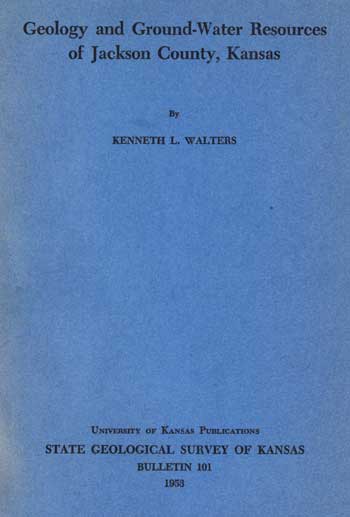Geology and Ground-Water Resources of Jackson County, Kansas
by Kenneth L. Walters

Originally published in 1953 as Kansas Geological Survey Bulletin 101. This is, in general, the original text as published in 1953. The information has not been updated.
You may also wish to visit our web site on the Jackson County geologic map.
Abstract
This report describes the geography, geology, and ground-water resources of Jackson County in northeastern Kansas. The county has an area of 658 square miles and had a population of 11,087 in 1946. It consists predominantly of rolling bills and has an intricate drainage system. Near the largest streams the surface is deeply dissected and the relief is pronounced. The climate is humid, the average annual precipitation being about 32 inches. General farming and livestock raising are the principal occupations in the county.
The rocks that crop out in this area range in age from Pennsylvanian to Recent. The oldest formation cropping out in the county is the Cedar Vale shale which is exposed in eastern Jackson County. Pleistocene glacial drift comprises the surface material in a large area in central and northern Jackson County and yields moderate quantities of water to wells. The alluvium is the youngest deposit in the county and also yields moderate quantities of water to wells.
This report contains a map showing the areas of outcrop of the rock formations, a map showing the location of test holes and wells for which records are given, and cross sections of the area showing the character and thickness of the formations overlying the Pennsylvanian and Permian bedrock.
The ground-water reservoir is recharged from precipitation that falls within the area, by percolation from streams, and by underflow from adjacent areas. Ground water is discharged from the ground-water reservoir by seepage into streams, by transpiration and evaporation, by movement into adjacent areas, and by wells and springs.
Most of the wells in the county are drilled or dug. No irrigation is practiced in Jackson County.
Ground water in Jackson County is generally hard, but except for individual wells that are contaminated by surface seepage--the water is suitable for most uses.
The field data upon which this report is based are given in tables. They include records of 255 wells, chemical analyses of water from 24 representative wells, and logs of 47 test holes.
Kansas Geological Survey, Geology
Placed on web Aug. 9, 2007; originally published June 1953.
Comments to webadmin@kgs.ku.edu
The URL for this page is http://www.kgs.ku.edu/General/Geology/Jackson/index.html